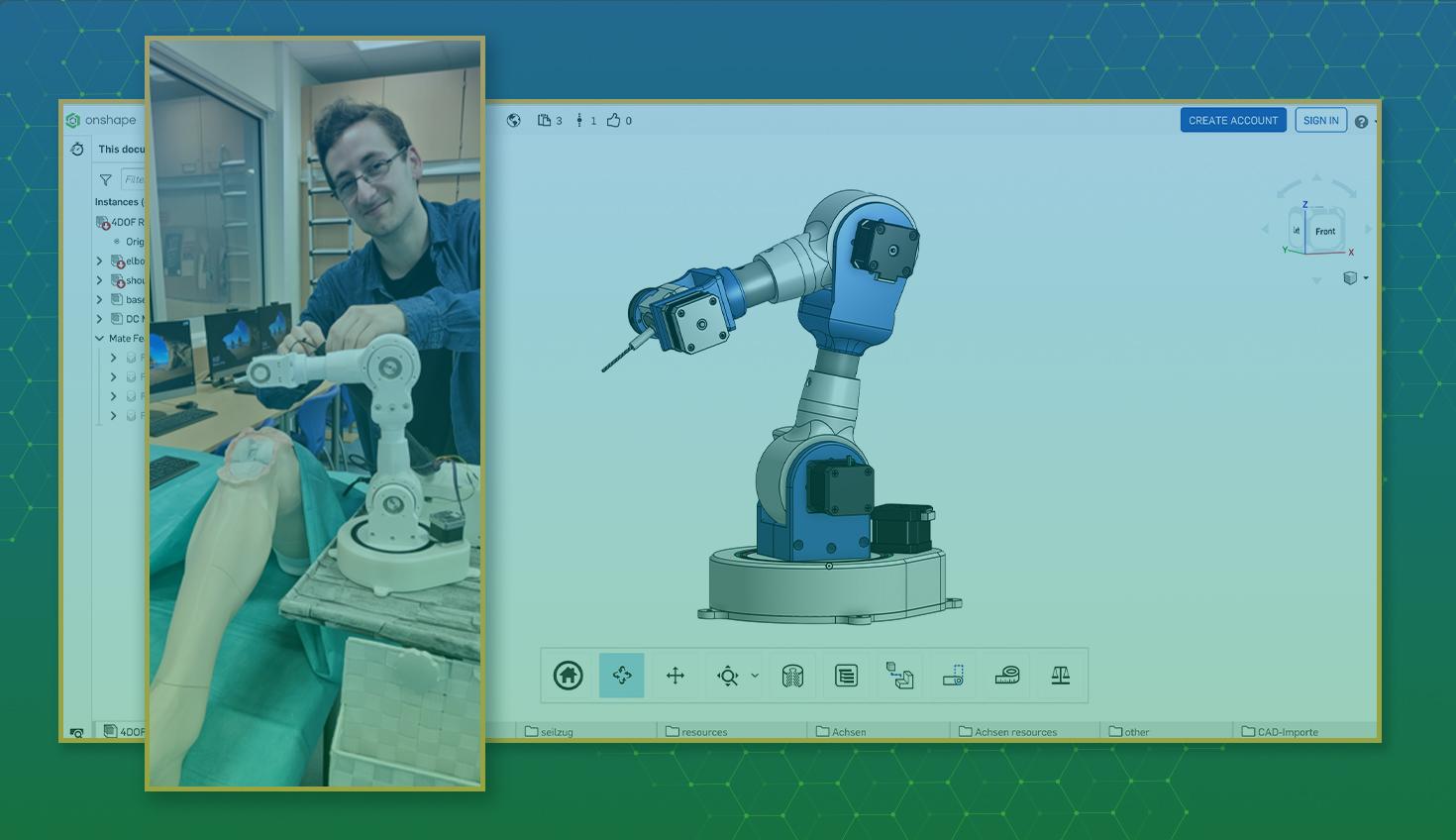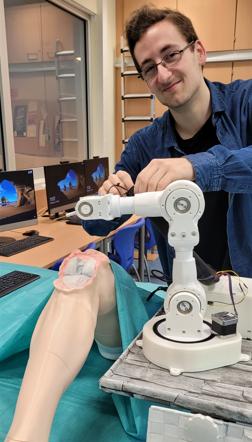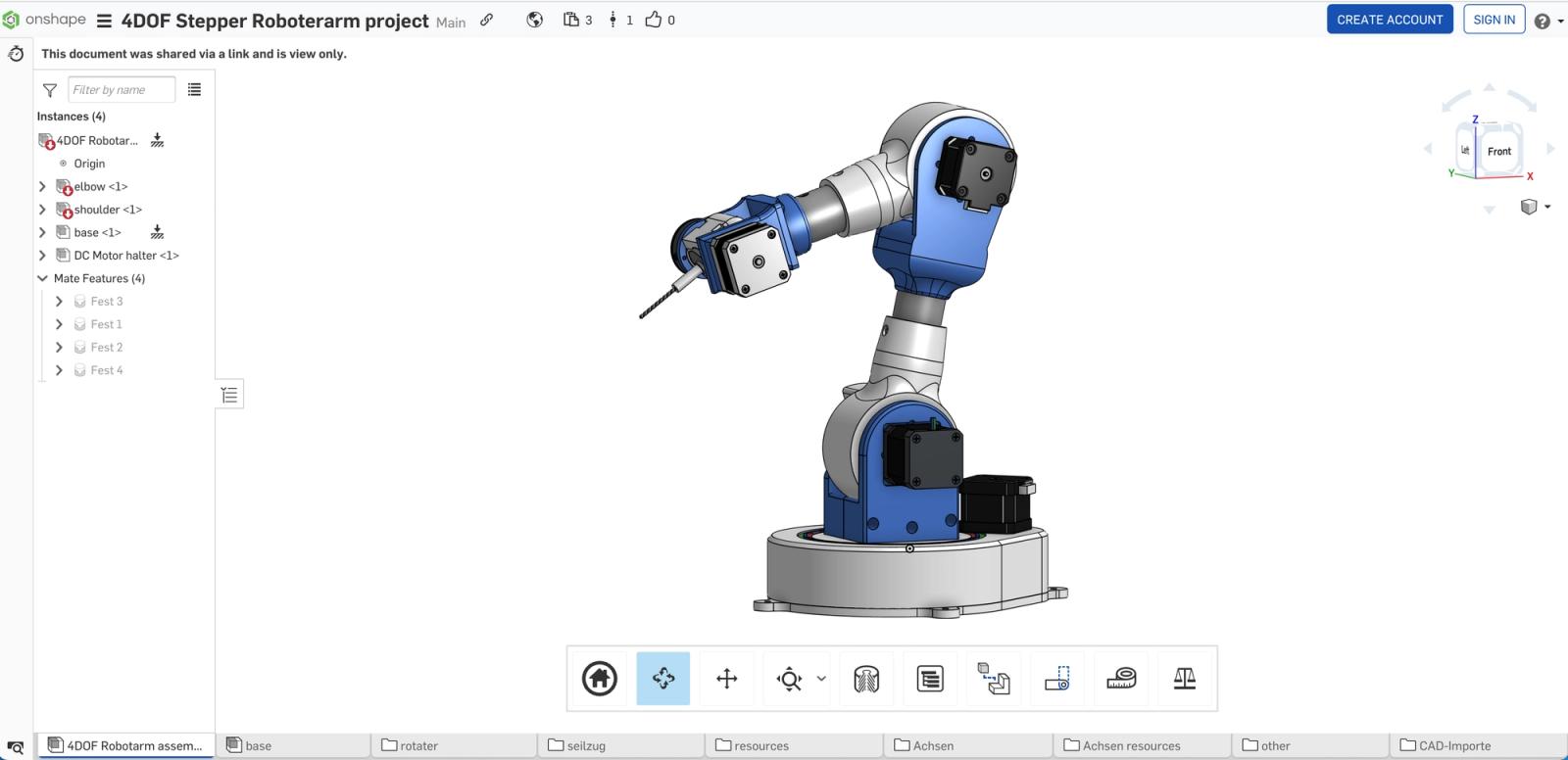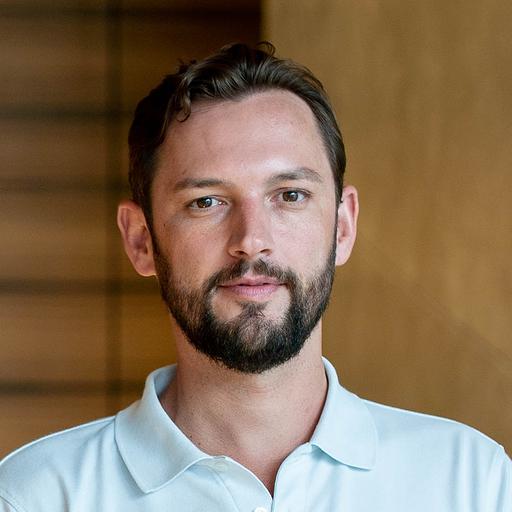
4:55
A student from Gymnasium in den Filder Benden, a K-12 school in Moers, Germany, achieved a remarkable feat by developing a surgical robot arm and software that can automatically perform knee replacement surgery all before graduation.
The project highlights the integration of professional-level tools, like Onshape’s cloud-native CAD software, as key to its development.
Steve Sandhoop demonstrates his surgical robot arm.

Merging Education and Advanced Technology
Steve Sandhoop, a 19-year-old high school graduate with a penchant for computer science, embarked on a unique journey under the guidance of Marc Lachmann, a dedicated computer science teacher.
Sandhoop’s objective was to create and demonstrate a surgical robot arm capable of replacing damaged cartilage in a knee joint with an implant. The intricacy of the project necessitated a systematic approach – something Sandhoop didn’t initially expect.
"I thought I'd just program the control of off-the-shelf components and be done with it,” said Sandhoop.
He ended up doing much more than expected. Sandhoop meticulously designed anatomically precise knee models for 3D printing using PTC’s cloud-native CAD software Onshape, engineered custom gears to ensure accuracy and developed intricate control software.
Then, Sandhoop 3D printed the parts of the robot and assembled them. Only for the motors he did resort to off-the-shelf models.
His project’s success was preceded by about two years of development work.
"Even though the project counts as an A-level subject, I did everything on my own in my free time, with the support of my mentor, Mr. Lachmann," Sandhoop reported. "Some of it was more complicated than I had imagined, but it taught me an incredible amount about mechatronics, physics, and also anatomy. I think what I learned most from the project was problem-solving and perseverance. Now I would like to continue in the direction of 'Scientific Programming.'"
Lachmann mentioned how proud he is of his student.
Onshape: A Cornerstone of Innovation
Central to the project's realization was Onshape, which facilitated the visualization and refinement of Sandhoop's designs. Through real-time collaboration with his mentor and other sources, Sandhoop harnessed Onshape's capabilities to fine-tune his creations, streamlining the development process.
“Because Onshape is web-based, it doesn't need to be installed on a classroom machine. Pupils can use it anytime from anywhere, be it at school or at home, from their cell phone, tablet, or laptop,” Lachmann said in a press release. “In addition, Onshape is free for educational purposes. This professional platform is ideal for working together in project teams or school classes.”

The journey to success wasn’t without hurdles. Sandhoop tackled challenges such as designing a cycloidal gearbox to facilitate precise movements in tight spaces. Sandhoop sought guidance from medical professionals and experts at academic institutions, highlighting his adaptability and willingness to explore diverse avenues – and also underlining Onshape’s unique collaboration and sharing features that made it possible.
Precision in Programming: Driving Automation
The robotic arm is controlled by a digital twin via a graphical user interface. To further automate the process, the area to be removed can be selected in the knee model.
To this end, the student worked with surgeons to design a 3D model of an anatomically correct knee joint bone and, in addition – to better illustrate the operation – modeled an entire leg with the bones and also printed it out using a 3D printer. The robotic arm can independently drill out the pre-marked area of the bone. The path of the drill is calculated by an algorithm developed in-house.
Sandhoop used the path-fill algorithm to enable the robotic arm to autonomously remove a selected area on the knee. This particular algorithm creates a one-dimensional path that completely traverses a simple surface, such as a quadrilateral, and can be applied to any polygon. In addition, this path has been converted into a three-dimensional projection to maximize the efficiency and precision of the robot-assisted surgery.
Programming played a pivotal role in enabling the robot arm's functionality. Sandhoop's coding proficiency was evident in the control system he developed. The robot arm can execute intricate surgical maneuvers with a single command on a laptop. His pathfill algorithm, programmed to calculate precise drilling paths, showcases his prowess in coding along with his experiences writing programs, developing computer games, and creating an app for his mother’s restaurant.
Nurturing Innovation Through Education
The project's triumph reveals the potential of cultivating innovation starting in the classroom. The Gymnasium in den Filder Benden exemplifies the transformative influence of granting students access to advanced tools and technologies, like Onshape.
“Our school has made great efforts into enabling students to have further insight into STEM subjects,” Sandhoop said on the “Third Angle” podcast. “We have built a fabricating laboratory (Fab Lab) with laser cutters, 3D printers, and all sorts of machines.”
Sandhoop's work serves as a testament to the positive outcomes that arise from empowering students to engage with cutting-edge technology.
“I was lucky to be at that school to have access to all these kinds of machines,” he continued. “The project has made me more curious about all the kinds of subjects I explore, from physics to anatomy to mechanics, and I’ve learned a lot.”
Pioneering Student-Driven Innovation
As Sandhoop prepares for the next phase of his academic journey, his achievements inspire the engineering field. With aspirations in computer science and mechatronics, Sandhoop's trajectory highlights the ample prospects available to young minds with a passion for innovation and exploration.
The professional result of Sandhoop’s project was compared to a bachelor thesis and generated widespread media coverage. The highlight was an invitation to Germany's largest tinkerer and hobbyist fair, the Maker Faire, where he was given the opportunity to exhibit his knee surgery simulation.
Shortly after graduating from high school, WDR television, Radio KW, and numerous local newspapers had already reported on Sandhoop's achievement. In the meantime, the professional world has become aware of the student's work.
Get Started with Onshape Education
Onshape for Education brings CAD out of the computer lab and into the modern era.
Latest Content

- Case Study
- Industrial Equipment & Machine Design
Reframe Systems: Transforming Homebuilding with Digital Automation and Cloud-Native Onshape
09.25.2025 learn more
- Blog
- Aviation, Aerospace & Defense
- Branching & Merging
- Custom Features
- Learning Center
- Onshape Government
Why Aerospace & Defense Teams Choose Onshape for Product Development
12.18.2025 learn more
- Blog
- Evaluating Onshape
Cloud-Native CAD 2025 Wins: Revenue Growth, Real-Time Collaboration, Unified CAD-CAM
12.17.2025 learn more
- Blog
- Becoming an Expert
- Assemblies
- Simulation
Mastering Kinematics: A Deeper Dive into Onshape Assemblies, Mates, and Simulation
12.11.2025 learn more



